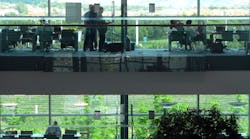The Aug. 23 news that investment banker Goldman Sachs wants all employees in its offices five days a week highlights just how quickly and dramatically the office environment has moved toward hybrid office strategies or remote officing since the COVID crisis — and its long-term impact on the demand for commercial office space.
The office market is one of the larger construction niches for electrical distributors, manufacturers, contractors, reps and other buying influences, and these companies feel the pain directly when demand for office space dries up in their local markets. New office construction accounts for 5% of all new construction project spending, according the Department of Census’ June 2023 data.
As more companies have shifted to hybrid work-from-home policies or 100% remote offices, many companies are slashing their office footprints or not renewing leases. An Aug. 23 Wall Street Journal article offered several recent examples of large firms making major cutbacks in office space. It said Aon is reducing office space in Chicago by 25% to 300,000 sq ft and that IBM slashed its Austin, TX, office space from 640,000 sq ft to 320,000 sq ft. The article also said Fluor is making an even more dramatic cut in the Houston area, cutting its office space in that market 70% to 308,000 sq ft, “in part because the company no longer assigns cubicles to employees who work on the road.”
Reduction in office space obviously has a direct impact on office vacancy rates. For many years, once a metropolitan area’s office vacancy rate touched 10%, the demand for new office construction was pretty solid, and only the slowest office construction markets had vacancy rates topping 20%. Today, few major cities have downtown office vacancy rate under 20% and at least two cities — Dallas/Ft. Worth (31.1%) and San Francisco (31.6%) — have office vacancy rates of more than 30%.
According to market data from CoStar and the Wall Street Journal report on the office market, the U.S. office vacancy rate increased to 13.2% from under 10% before the pandemic. The article said CoStar is forecasting that the U.S. office vacancy rate will top 17% by 4Q 2026.
While many companies are asking more employees to come into the office more often, indicators exist that the percentage of people actually working in corporate offices is still quite small. Kastle, a manufacturer of office access controls uses data from customers in 2,600 buildings in 138 cities to monitor office occupancy. The most recent Kastle Back to Work Barometer, a weekly occupancy report, showed that the average occupancy rate in its 10 top cities is only 47.2%. Only four cities — Dallas (52%); Houston (59.4%); Chicago (51.25); and Austin (56.5%) — have an occupancy rate of more than 50%.
The news in the office market is not all bad, as some segments, like Class A building that feature the latest in amenities, actually still enjoy fairly robust demand for new space. These buildings often offer the latest in green building technologies, flexible meeting facilities and on-site food services. There also appears to be a fairly robust market for retrofitting of existing office space to accommodate the new hybrid officing strategies.
One type of office retrofit work not seeing as much action is conversions to apartments. While the concept sounds great on paper because of the huge demand for new apartments in many cities, many older office buildings can’t easily be converted to apartments because of the location of plumbing and air conditioning systems, inefficient windows and other structural challenges. According to a report from the CBRE real estate advisory firm, “Although conversion activity has accelerated since the pandemic, project completions since 2016 account for less than 2% of the total U.S. office inventory. The high cost of both acquiring and converting a building has limited the viability of such projects.”
While the office market is facing its challenges, the trend toward commercial property remodeling is a positive for the electrical market. Statista says the market for commercial property remodeling in the United States reached $51 billion in 2022. The trend towards market growth began in 2012 and peaked in 2020, followed by two years of decline. According to the forecast, the market is expected to expand by about 2% in 2023.
— Jim Lucy




